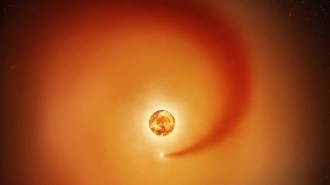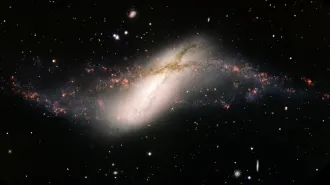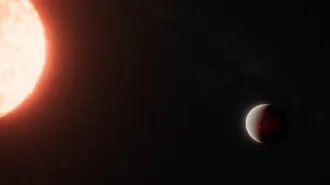The universe is seriously underweight, and most of the stuff in it is so-called vacuum energy—not properly stuff at all. That’s the conclusion emerging from the largest survey of galaxies to date.

At a meeting of the American Astronomical Society in Rochester, N.Y., this week, a team of British, Australian, and U.S. astronomers announced that it has now surveyed 100,000 galaxies. The researchers’ analysis shows that the density of all visible and dark matter in the cosmos is only a third of what would be required to account for a so-called flat universe. Yet earlier studies indicated that we do in fact live in a flat universe, one with just enough density to expand forever (SN: 12/19/98, p. 392: http://www.sciencenews.org/sn_arc98/12_19_98/Bob1.htm; 6/3/00, p. 363: available to subscribers at More evidence of a flat universe).
“The deficit must be made up by what is known as vacuum energy,” says team member Karl Glazebrook of Johns Hopkins University in Baltimore. This entity, predicted by some theories of particle physics, would resist the gravitational pull of galaxies and be evenly distributed throughout the cosmos, says Glazebrook. It would also act to increase the rate at which the universe expands. “Over the past few years,” says David N. Spergel, an astronomer at Princeton University, “the evidence for vacuum energy has gotten much stronger.”
The latest mapping, called the Two Degree Field (2dF) Galaxy Redshift Survey, helps confirm that vacuum energy solves the problem of missing mass. Using the Anglo-Australian Telescope near Coonabarabran, Australia, the astronomers surveyed galaxies’ redshifts, the amount by which cosmic expansion stretches light toward longer wavelengths.
Any redshift has a component due to the expansion of the universe and a much smaller component due to a galaxy’s individual motion, says team member Richard Ellis of the California Institute of Technology in Pasadena. Such motions arise from the gravitational tug of one galaxy on another, so statistical analysis of a redshift survey yields an estimate of the total mass of galaxies, Ellis explains.
More clues that cosmic expansion is revving up, says Spergel, come from observations of type Ia supernovas (SN: 3/21/98, p. 185). These exploding stars appear to be dimmer, and hence more distant, than astronomers would expect in a matter-dominated universe. “The data are well fit by a universe that is two-thirds vacuum energy and one-third matter,” says Spergel.
Previous cosmological maps had indicated a low-density universe. However, the 2dF map, which covers one-twentieth of the sky and probes the cosmos back to a depth of 4 billion light-years, is the most systematic survey to date. This thoroughness adds a degree of confidence to density estimates not previously possible.
The whole 2dF survey, which the team intends to complete in 2001, will include 250,000 galaxies. The distribution of those galaxies, says John Peacock of Edinburgh University in Scotland, one of the team’s coordinators, should reveal the tiny fluctuations in density present in the earliest moments of the universe. A more ambitious mapping, the Sloan Digital Sky Survey, aims to complete redshift measurements for 1 million galaxies—a quarter of the sky—by 2004, reaching a depth of nearly 8 billion light-years.







